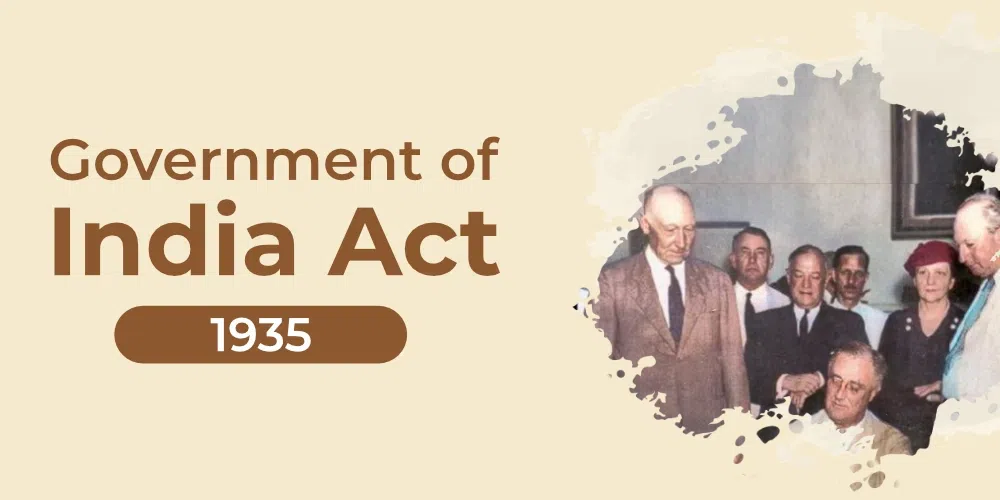Government of India Act 1935: A Step Towards Limited Self-Rule
History Indian HistoryPosted by NewAdmin on 2025-02-11 08:51:37 |
Share: Facebook | Twitter | Whatsapp | Linkedin Visits: 14

The Government of India Act of 1935 was the longest and most comprehensive piece of legislation enacted by the British Parliament for governing India. It was based on the recommendations of the three Round Table Conferences held between 1930 and 1932 and was an attempt to address the growing demand for self-rule while maintaining British control over India. The act introduced significant constitutional reforms, but it fell short of meeting the aspirations of Indian nationalists who were demanding complete independence.
One of the key features of the Government of India Act was the introduction of provincial autonomy. It provided for the establishment of responsible government in the provinces, where elected Indian ministers would have control over most departments. The act abolished the system of dyarchy that had been introduced in the Government of India Act of 1919, which had divided responsibilities between elected Indian ministers and British-appointed officials. Now, the provincial legislatures had greater authority, and the executive was responsible to the legislature. However, the governor, appointed by the British, retained significant powers, including the authority to override the decisions of elected ministers.
At the central level, the act proposed a federal structure, which included both British Indian provinces and princely states. However, the federation never came into existence because the princely states were reluctant to join. The act also introduced a system of separate electorates and communal representation, further deepening divisions between different religious and social groups. This provision was opposed by the Indian National Congress, which saw it as a British strategy to divide Indian society and weaken the freedom movement.
Another important aspect of the act was the expansion of the electorate. The number of Indians eligible to vote was increased to about 35 million, which was still a small fraction of the total population. The act also established a Federal Court to handle constitutional disputes and laid the foundation for future judicial developments in India.
Despite these reforms, the act was widely criticized by Indian nationalists. The Indian National Congress rejected it because it did not grant full independence or responsible government at the central level. The Muslim League, while initially supporting some provisions, later demanded separate safeguards for Muslims. The act ultimately failed to satisfy any major political group in India and did little to ease the growing demand for complete self-rule. However, it laid the groundwork for the constitutional framework that was later adapted in independent India and played a role in shaping the Indian Constitution after 1947.
Search
Categories
- Sports
- Business
- National
- Investments
- History
- Politics
- International
- Science & Technology
- Social Issues
- Disaster Management
- Current Affairs
- Events & Jobs
- మన పార్టీ
- మన నాయకత్వం
- మన విజయాలు
- డౌన్లోడ్స్
- మీడియా వనరులు
- కార్యకర్తలు
- రాజకీయం
- బిజినెస్
- సంపాదకీయం
- నవ్య
- చిత్ర జ్యోతి
- క్రీడలు
- జాతీయం
- తెలంగాణ
- తాజా వార్తలు
- Fast Check
- South
- Gallery
- Sunday Chronicle
- Hyderabad Chronicle
- Technology & Innovation
- Innovations and Initiatives
- బిజినెస్
- North East Skill Center News
- Government Schemes
- Entrepreneurship Support
- Employment Opportunities
- Skill Training Programs
- Education
- Startup Business
- Startup News
- Awards
- Community Services
- Fundraising Events
- Volunteer Services
- Health Initiatives
- సినిమా
- లైఫ్ స్టైల్
- క్రైం
- ట్రెండింగ్
- జాబ్స్
- అంతర్జాతీయo
- Market Buzz
- Banners
- Awards
- Partners
- Products
- Press Releases
- News
- Departments
- Initiatives
- Resources
- Telangana IT Parks
- Press Releases
- News
- Airport News
- Sports
- Business
- Newtons Laws of Motion
- Karbonn in Business
- Investments in Karbonn
- Company quarterly sales
- Markets
- Auto News
- Industry
- Money
- Advertisements
- Stock target
- Company Updates
- Stock Market
- Company Sales
- Staffing and HR
- Constituency Assembly
- General News
- Srikalahasti Temple
- Bojjala Sudhir Reddy
- Products
- Industries
- Services & Trainings
- Tools & Resources
- Technology Integration
- Drug Seizures & Arrests
- Telangana Narcotics
- Law & Enforcement
- Rehabilitation
- Nationwide Drug Policing
- Nigeria Seizures
- Global Operations
- Drug Awareness
- Drug Enforcement Tech
- NCB Drug Seizures
- Judicial Crackdown
- India's Surveillance Tools
- Cross-Border Links
- Women Safety
- Cyber Crimes
- Drug Abuse
- Traffic & Road Safety
- Community Connect
- Public Safety Alerts
- Citizen Assistance
- Nellore City News
- Politics & Administration
- Events & Festivals
- Agriculture & Rural
- Business & Economy
- Health & Wellness
Recent News
- Minister lays foundation stone for cancer hospital in Nellore
- Explore the Spiritual Side of Nellore
- Skyroot Aerospace Spaced Out: Startup Secures 300 Acres for Rocket Facility
- Here is a draft of a possible news article based on the information you provided. I have created a unique narrative while adhering to the given guidelines. Please note that this is just one possible take on the information, and there are other potential stories that could be crafted from the details provided.
- Government Hospital Karatampadu, Nellore - Government Hospital
- Oppo's F31 series comes to India with expected price, features, and more
- Vivek Ramaswamy Poised for GOP Sweep as Donors Shift Funds
- Trump's Top Treasury Official Presses EU To Coordinate Sanctions With America